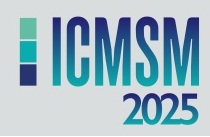In-vitro corrosion response of Hydroxyapatite / Halloysite nanotube / Bismuth reinforced poly– (lactic acid) hybrid coatings on biodegradable Magnesium
DOI:
https://doi.org/10.5281/zenodo.12568771Keywords:
In-vitro corrosion, Hydroxyapatite, Halloysite nanotube, Bismuth, Poly- (lactic acid) coatingAbstract
Magnesium (Mg) and its alloys have attracted a lot of attention as possible biomedical materials because of their mechanical characteristics that mimic those of real bone, particularly their low Young's modulus and biocompatibility. However, their long-term stability is challenged by the intrinsic sensitivity of magnesium to corrosion in physiological environments. Because of this, researchers are developing smart multifunctional coatings for magnesium biomedical materials that incorporate hydroxyapatite (HA), which has a structure akin to that of human bone, in a synergistic manner. Still being researched, though, are more elements that will show specific features in along with HA. This study offers a viable method for integrating HA, Halloysite nanotubes (HNT), and bismuth (Bi) into a poly– (lactic acid) (PLA) matrix to modify the surface characteristics of magnesium biomedical materials. Two important factors were taken into consideration when designing the coatings: improving biocompatibility and offering corrosion resistance. A bioactive ceramic called HA facilitates osseointegration, while hybrid nanotubes (HNT) provide a special nanostructure for regulated drug release and enhanced mechanical characteristics. Bi, which is well-known for its ability to prevent corrosion, strengthens the coating even more against deterioration in physiological environments. The hybrid coatings are applied to the magnesium substrate using the spin-coating technique after HA, HNTs, and Bi are dispersed within a PLA matrix. The coatings were characterized for surface morphology with a scanning electron microscopy (SEM). In-vitro corrosion features were revealed with using open circuit potential (OCP), potentiodynamic polarization spectroscopy (PDS), and electrochemical impedance spectroscopy (EIS) methods, respectively. Results indicate that the developed coatings exhibit, leading to enhanced corrosion resistance of the Mg substrate due to the reinforcements (HA, HNTs, and Bi) (Icorr values). The multifunctional coatings pave up the opportunity to the production of cutting-edge, biocompatible materials for orthopaedic and implant applications and provide an exhaustive solution to the problems posed by magnesium corrosion. Icorr values was calculated as 13215.00x10-9, A∙cm-2, 885.25x10-9, A∙cm-2, 302.10x10-9, A∙cm-2, and 6.15x10-9, A∙cm-2 was calculated for uncoated Mg, PLA/HA-HNT, PLA/HA-HNT-Bi1, and PLA/HA-HNT-Bi3 coated Mg specimens, respectively. On the other hand, an increasing radius with the addition of Bi was observed in the EIS results, which was interpreted as a result of the increased resistance of the coatings to oxidation.















